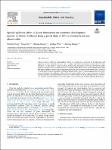Item Infomation
Full metadata record
| DC Field | Value | Language |
|---|---|---|
| dc.contributor | Yong Yin | - |
| dc.contributor | Change Kuang | - |
| dc.contributor | Zezhou Wen | - |
| dc.contributor | Jinsong Kuang | - |
| dc.contributor.author | Wenbin Peng | - |
| dc.date.accessioned | 2024-10-10T03:35:27Z | - |
| dc.date.available | 2024-10-10T03:35:27Z | - |
| dc.date.issued | 2021 | - |
| dc.identifier.uri | http://thuvienso.thanglong.edu.vn//handle/TLU/11404 | - |
| dc.description.abstract | Green innovation, which has spatial spillover effects, is a crucial way to accelerate the transformation and upgrading of urban economic structure, then to achieve sustainable development for the urban in China. Therefore, it is meaningful to study the effects of urban green innovation on economic development quality (EDQ). In this paper, using the panel data of 270 cities during 2005–2017 in China, we investigated spatial effect and effect decomposition result of green innovation on EDQ by applying Spatial Durbin Model (SDM). The results revealed that both green innovation and EDQ had demonstrated a trend of regional agglomeration and fluctuating development; the coefficient of direct effect and spatial spillover effect of green innovation on EDQ is significantly positive, green innovation is conducive to enhance EDQ in local city and adjacent cities. Therefore, it is necessary to put forward green innovation policy recommendations for around sustainable development. | vi |
| dc.format.extent | 9tr. | vi |
| dc.language.iso | en | vi |
| dc.publisher | Elsevier Ltd | vi |
| dc.relation.ispartofseries | Sustainable Cities and Society 69 (2021) 102863; | - |
| dc.subject | Spatial spillover effects | vi |
| dc.subject | Green innovation | vi |
| dc.subject | Sustainable development | vi |
| dc.subject | EDQ | vi |
| dc.title | Spatial spillover effect of green innovation on economic development quality in China: Evidence from a panel data of 270 prefecture-level and above cities | vi |
| dc.type | Bài báo/Newspaper | vi |
| dc.identifier.doi | https://doi.org/10.1016/j.scs.2021.102863 | - |
| Appears in Collections | Lĩnh vực Khoa học quản lý | |
Files in This Item:



